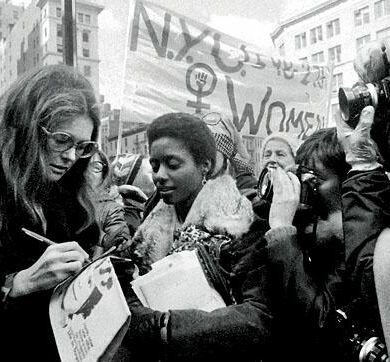When will the clock strike for the next Women’s Movement?
Featured, Women — By Angela Stanley on January 14, 2010 at 07:21It’s time for a revolution. Women have been taking some hard hits that have gone unanswered for far too long. From the recent women’s health care recommendations to the reified overly narrow standards of beauty, the state of women in America is rapidly devolving. In an era where “change” has been the theme, women need to follow suit and demand some as well.
“It was something else, but I don’t believe it was ‘rape’ rape”
Rape and domestic violence have gotten a good deal of media attention over the last year. Chris Brown infamously attacked his then girlfriend Rihanna, reality television contestant Ryan Jenkins assaulted and ultimately gruesomely murdered his new wife Jasmine Fiore before killing himself, and Roman Polanski reemerged with his 30 year old statutory rape case in tow.
As one might expect, these events got a lot of people talking and taking sides. In the case of Chris Brown, it was shocking to see the number of people, many of whom were women, wondering what Rihanna did to provoke her own attack. As for Roman Polanski, the number of celebrities coming to his defense claiming that the sex Polanski had with a 14 year old was consensual and not really rape was astounding.
Whoopi Goldberg has repeatedly supported both Chris Brown and Roman Polanski stating that in both cases no one knows all the details; in terms of Chris Brown and Rihanna, maybe Rihanna also hit him; and as for Polanski, it wasn’t “rape” rape.
What was more alarming was the number of girls who blamed Rihanna for her situation. It also seemed that girls and women of color were quick to question what she did to provoke her own assault.
As Kim Gandy, president of the National Organization for Women, stated, “Blaming the victim has gone on as long as I can remember, both in sexual assault and domestic violence. When I started working on domestic-violence issues in the 1970s, women would not come forward because they knew they would be blamed, no matter how blameless they knew they were. Maybe they hadn’t ironed his shirt right, or burned the toast, or ‘done something’ to justify being beaten.”
According to NOW, women ages 20-24 are at the greatest risk for non-fatal domestic violence, women 24 and under suffer the highest rates of rape, Black women face higher rates of domestic violence than White, and American Indian women are victimized at twice the rate of any other race.
So the very people who are most likely to be victims of domestic violence are often the ones who defend it. Perhaps it’s part of the “it won’t happen to me” mindset. Maybe we’re all just desensitized. Or maybe women and girls are not being taught to understand what their rights are, what sexism is, how domestic violence operates, and what healthy relationships look like.
“There’s no benefit to performing breast self-exams”
Recent health care recommendations regarding mammograms and pap smears have had many women, as well as women’s health care advocates and providers, up in arms. The American College of Obstetricians and Gynecologists recommended recently that cervical cancer screenings should start at age 21 instead of 18 and should not be done annually. Even more concerning are the U.S. Preventative Services Task Force recommendations for mammograms stating that that starting age should be moved up to 50 from 40 and should occur biennially instead of annually. Further, the task force recommends against teaching breast self-exams claiming that there is no benefit.
Even though there is no cure for cancer, prevention and early detection should be pretty high on the priority list. But advances in women’s health care, and reproductive health in general, seems to be behind the curve. So often women are presented with the sole option of a hysterectomy when reproductive issues become a problem, but there seems to be dozens of way for men to maintain and achieve erections. This is not to suggesting that erections aren’t important but when we’re comparing them to, say, saving a woman’s uterus, ovaries, and fallopian tubes and preventing sudden sterility and early menopause, then one has to think about perspective and priorities. When women’s health is placed so low on the totem pole that even self-exams aren’t recommended, people should be alarmed.
“…someone should tell Michelle to mix up her wardrobe and cover up from time to time.”
The presence of Michelle Obama, Hillary Clinton, Sarah Palin, and Cindy McCain in the political sphere makes it clear that media attention is vastly different for women. During the campaign season for the 2008 presidential election, there was an overarching emphasis on the physical appearance of all four women, two of which were spouses not seeking election to anything, that didn’t exist in the same way for Barack Obama, John McCain, Bill Clinton, or Todd Palin. Sure there were occasional jokes about expensive haircuts and age related banter for the men, but it never threatened to overshadow the individuals as it did for the women.
For the men, never was the bulk of the focus on attire, wrinkles or lack there of, speculation about cosmetic surgery, or arm definition. The women, however, faced and entirely different battle. Rush Limbaugh was quoted in 2008 saying, “Will Americans want to watch a woman get older before their eyes on a daily basis? And that woman, by the way, is not going to want to look like she’s getting older, because it will impact poll numbers. It will impact perceptions.”
Gloria Steinem tackled this very issue back January of 2008 in a New York Times op-ed. “So why is the sex barrier not taken as seriously as the racial one? The reasons are as pervasive as the air we breathe: because sexism is still confused with nature as racism once was; because anything that affects males is seen as more serious than anything that affects “only” the female half of the human race…because racism stereotyped black men as more “masculine” for so long that some White men find their presence to be masculinity-affirming (as long as there aren’t too many of them); and because there is still no “right” way to be a woman in public power without being considered a you-know-what.”
So intelligence and résumés aside, Hillary Clinton is an aging, “you-know-what”; Sarah Palin is too cute for her own good (she’s even made claims that Newsweek was sexist for putting her on a recent cover in running shorts); Cindy McCain is a plastic surgery having ice queen; and Michelle Obama is just too risqué and one-note with all of her arm showing and bare legs (at least the media has moved on from trying to make her into and militant, Angry Black Woman). All this boils down to one question: why are people talking about this? Or at least, aren’t there better things to talk about? Perhaps a reminder needs to be sent out that it is possible to be attractive and smart at the same time. It is fine to be a woman and not wear dresses or pantyhose 24/7 or have a preference for something sleeveless. And it’s ok for women, just like men, to get older.
One would think that with women firmly represented in all areas of the political arena—Secretary of State, Speaker of the House, First Lady, presidential candidate, vice-presidential candidate, governor, senator, etc.—that it would be less shocking and people could relax and treat them as they would anyone else. Apparently America still isn’t ready for modern women in politics, no matter what the level. It’s unfortunate that in 2010, women with opinions or impressive careers or positions of power still have to contend with superficial assessments and being labeled a…”you-know-what.”
Barbie’s ankles are too fat
 It’s not enough that if Barbie were real, she’d be a pencil thin Amazon with an 18” waist, but apparently now her ankles are too fat to wear 5” red-bottomed, Christian Louboutin stilettos. At least that’s what he says and thank goodness he has thinned out those ankles for his new Barbie collection. And Karl Lagerfeld so infamously said in 2009, “No one wants to see curvy women…You’ve got fat mothers with their bags of chips sitting in front of the television and saying that thin models are ugly.”
It’s not enough that if Barbie were real, she’d be a pencil thin Amazon with an 18” waist, but apparently now her ankles are too fat to wear 5” red-bottomed, Christian Louboutin stilettos. At least that’s what he says and thank goodness he has thinned out those ankles for his new Barbie collection. And Karl Lagerfeld so infamously said in 2009, “No one wants to see curvy women…You’ve got fat mothers with their bags of chips sitting in front of the television and saying that thin models are ugly.”
By now, one would think there would be a broader definition of beauty. But still, thin seems to be in. Even if a woman is from a culture where curvier women are more accepted, the idealized thin-waisted, Coke bottle figure is also an image that not everyone can attain. So the idea that you have to either be a size zero or built like Beyoncé leaves most women by the wayside.
 And speaking of Beyoncé, the recent L’Oreal commercials featuring her, Eva Longoria Parker, and Elizabeth Banks demonstrate how narrowly we think of beauty and skin color. Despite all three women being of different races, the range in skin color is miniscule. Where does this leave little girls who aren’t the same color or shape or size of the women they admire who are constantly praised and glorified for their beauty and mass appeal?
And speaking of Beyoncé, the recent L’Oreal commercials featuring her, Eva Longoria Parker, and Elizabeth Banks demonstrate how narrowly we think of beauty and skin color. Despite all three women being of different races, the range in skin color is miniscule. Where does this leave little girls who aren’t the same color or shape or size of the women they admire who are constantly praised and glorified for their beauty and mass appeal?
Understanding sexism through racism
This list can go on an on. From continued issues of equal pay for equal work, the backlash against public breast feeding, and the ceaseless battle to limit abortion rights to Black women being blamed and held solely responsible for the supposed “marriage crisis” and domestic abuse being labeled a pre-existing condition not coverable by insurance, the quality of life and equal rights for women are regressing dramatically.
Understandably, people will make arguments for how well off American women are in comparison to decades ago or even to other countries. However, claiming that present-day American women have it the best doesn’t say anything about how things really are. The comparison should be between men and women rather than among women to accurately understand the glaring chasm. And what’s even more frustrating is we’ve gotten so far away from women’s rights being on the table, that many women and girls don’t even see the problem. As Gloria Steinem pointed out, sexism isn’t taken as seriously as racism, it’s considered a natural part of life, and what affects men is often given more weight, attention, and credibility.
Interestingly, this is the same way racism once worked (and sometimes still does), and very few are willing to take the time to see that racism and sexism operate in very similar ways. We need to take what we know and understand about racism to deal with the root of sexism and everything that stems from it.
In her book, Deals with the Devil: And other Reasons to Riot, Pearl Cleage makes note that the racial history of America is an invaluable tool for understanding sexism. Speaking specifically of Black men, she says, “Black men who have experienced racism are already familiar with what oppression looks like, how it operates, how it can permeate and poison every area of your life. The problem is, we have not figured out a way to use that racial knowledge to help them understand sexism and their role in it.”
We need to build upon this idea. We need to take what we know about racism and other forms of oppression and use it as a tool to lessen the chokehold of all of the other “isms” and phobias that exist to limit the lives, happiness, potential, and opportunities of those who have been arbitrarily deemed outsiders by self-serving oppressors. In this era of change and progress, we need to put women’s rights back on the table. It’s time to take a stand and stop the backslide. It’s time for women to know their worth and for girls to be proud. It’s time for a revolution.
Tags: Contemporary women's issues, health care, Politics, racism, Women, women's liberaton, women's rightsAuthor: Angela Stanley (5 Articles)

Angela Stanley is a research associate at the Kirwan Institute. She is a graduate of Purdue University and Ohio State University. Her research and writing interests include race, gender, American politics, intersectionality, public policy, and popular culture.



 Share This
Share This Tweet This
Tweet This Digg This
Digg This Save to delicious
Save to delicious Stumble it
Stumble it





 10 Reasons not to read this
10 Reasons not to read this A Few Words In Defense of the N-Word, in the Novels of Mark Twain
A Few Words In Defense of the N-Word, in the Novels of Mark Twain Indigenous voices must be heard in Copenhagen
Indigenous voices must be heard in Copenhagen A fast year: Lessons from the Indian Health System
A fast year: Lessons from the Indian Health System







